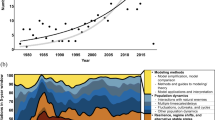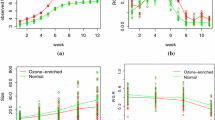Abstract
This discussion paper describes the attempt of an imagined group of non-ecologists (“Modellers”) to determine the population growth rate from field data. The Modellers wrestle with the multiple definitions of the growth rate available in the literature and the fact that, in their modelling, it appears to be drastically model-dependent, which seems to throw into question the very concept itself. Specifically, they observe that six representative models used to capture the data produce growth-rate values, which differ significantly. Almost ready to concede that the problem they set for themselves is ill-posed, they arrive at an alternative point of view that not only preserves the identity of the concept of the growth rate, but also helps discriminate between competing models for capturing the data. This is accomplished by assessing how robustly a given model is able to generate growth-rate values from randomized time-series data. This leads to the proposal of an iterative approach to ecological modelling in which the definition of theoretical concepts (such as the growth rate) and model selection complement each other. The paper is based on high-quality field data of mites on apple trees and may be called a “data-driven opinion piece”.




Similar content being viewed by others
Notes
One such gap is a thorough discussion of other approaches and areas relevant to the topic of this paper, such as the important and rapidly growing field of bioinformatics.
In addition to the quoted paper by Berryman (2003), interested readers might find contributions such as O’Hara (2005), Ginzburg et al. (2007), Lockwood (2008), Raerinne (2013) useful as potential entry points into the pertinent literature, which also contain older and widely discussed contributions such as Levins (1966) and Turchin (2001).
In this paper we use continuous-time models throughout. However, the discussion could equally be applied to discrete-time models.
This data set is remarkable for its quality and detail, and it has therefore recently attracted renewed interest. While various aspects of the data have been described in the literature (Herbert and Sanford 1969; Herbert 1970; Hardman et al. 1985; Marshall and Pree 1991), some of the raw data have apparently never been analyzed.
We agree with Chester (2012) who argues that, if the growth rate is allowed to depend on time, it loses its meaning and utility.
Taylor (1979) used life-table data of various insect and mite species to estimate the time for the populations to get within 5% of the stable age distribution (SAD). According to those estimates, it is conceivable for some species to approach the SAD within a season.
In keeping with the the notation used by Lotka and Fisher, we adopt the continuous-time-continuous-age framework, in which \(\rho (t,a)\) represents the number of age–\(a\) organisms at time \(t\) and the time and age variables \(t\) and \(a\) are allowed to vary continuously in \((0,\infty )\). Our notation is similar to the one in Cushing (1998); see also Webb (1985).
Although not considered in this note, we mention that in the discrete-time-discrete-age framework of Leslie matrix models, \(v(a)\) is given by the dominant left eigenvector of the transition matrix. (The dominant right eigenvector corresponds to the stable age distribution; the logarithm of the dominant eigenvalue to Lotka’s \(r\).) For more information on matrix models, as well as structured population models in general, see Caswell (2001).
Even if the demographic data (fecundity and mortality) as functions of age are piecewise constant, \(v(a)\) is not piecewise constant, but piecewise exponential.
All models considered in this paper are continuous in the time variable. Discrete-time models were also tested, but they did not provide any advantage; neither in terms of modelling, nor in terms of fitting the data or determining the growth rate.
Each new data set is the average of 10 randomly selected replicates.
In fact, for the data set at hand the Modellers were somewhat unsatisfied with the results of standard model-selection techniques, such as AIC. This motivated them to look for additional criteria such as the ones described in the present paper.
Philosophers, even philosophers of science, may feel differently about this, however: we note with interest that Nancy Cartwright (1983) uses the word “believe” 15 times in the introductory chapter of her book alone.
For a better–founded account of the utility of philosophy in biology, see Orzack (2012).
which, in reference to Nancy Cartwright’s concept of “nomological machines”, we are tempted to call “nomological mathchines”
References
Berryman AA (2003) On principles, laws and theory in population ecology. Oikos 103:695–701
Cartwright N (1983) How the laws of physics lie. Clarendon Press, Oxford
Cartwright N (1999) The dappled world: a study of the boundaries of science. Cambridge University Press, Cambridge
Caswell H (2001) Matrix population models. Sinauer Associates, Sunderland
Caughley G (1977) Analysis of vertebrate populations. Wiley, New York
Chester M (2012) A fundamental principle governing populations. Acta Biotheor 60:289–302
Cushing JM (1998) An introduction to structured population dynamics. Society for Industrial and Applied Mathematics, Philadelphia
Evans MR, Grimm V, Johst K, Knuuttila T, de Langhe R, Lessells CM, Merz M, O’Malley MA, Orzack SH, Weisberg M, et al. (2013) Do simple models lead to generality in ecology? Trends Ecol Evol 28(10):578–583
Fisher RA (1927) The actuarial treatment of official birth records. Eugen Rev 19:103
Ginzburg LR, Jensen CX, Yule JV (2007) Aiming the “unreasonable effectiveness of mathematics” at ecological theory. Ecol Model 207:356–362
Gould JM (2007) Age-structured population models for species of pest mites. Master’s Thesis, Acadia University
Hardman J, Herbert H, Sanford K, Hamilton D (1985) Effect of populations of the European red mite, Panonychus ulmi, on the apple variety red delicious in Nova Scotia. Can Entomol 117:1257–1265
Herbert H (1970) Limits of each stage in populations of the European red mite, Panonychus ulmi. Can Entomol 102:64–68
Herbert H, Sanford K (1969) The influence of spray programs on the fauna of apple orchards in Nova Scotia: XIX. Apple rust mite, Vasates Schlechtendali, a food source for predators. Can Entomol 101:62–67
Levins R (1966) The strategy of model building in population biology. Am Sci 54(4):421–431
Lockwood DR (2008) When logic fails ecology. Q Rev Biol 83:57–64
Lotka AJ (1922) The stability of the normal age distribution. In: Proceedings of the National Academy of Science, vol 8, pp 339–345
Marshall D, Pree D (1991) Effects of miticides on the life stages of the European red mite, Panonychus ulmi (koch) (acari: Tetranychidae). Can Entomol 123:77–87
McCallum H (2008) Population parameters: estimation for ecological models. Wiley, New York
O’Hara R (2005) The anarchist’s guide to ecological theory. Or, we don’t need no stinkin’ laws. Oikos 110:390–393
Orzack SH (2012) The philosophy of modelling or does the philosophy of biology have any use? Philos T R Soc B 367:170–180
Raerinne J (2012) Robustness and sensitivity of biological models. Philos Stud 166:285–303
Raerinne J (2013) Stability and lawlikeness. Biol Philos 28:833–851
Sibly R, Hone J (2002) Population growth rate and its determinants: an overview. Philos T R Soc B 357:1153–1170
Taylor F (1979) Convergence to the stable age distribution in populations of insects. Am Nat 113(4):511–530
Tenhumberg B (2010) Ignoring population structure can lead to erroneous predictions of future population size. Nat Educ Knowl 3(10):2
Turchin P (2001) Does population ecology have general laws? Oikos 94:17–26
Walthall W, Stark J (1997) Comparison of two population-level ecotoxicological endpoints: the intrinsic (\(r_m\)) and instantaneous (\(r_i\)) rates of increase. Environ Toxicol Chem 1:1068–1073
Webb G (1985) Theory of nonlinear age-dependent population dynamics. CRC Press, New York
Acknowledgments
This research was supported by a Discovery Grant of the Natural Sciences and Engineering Research Council of Canada (NSERC); MD also acknowledges support by NSERC through an undergraduate scholarship. HT would like to thank the Basque Center for Applied Mathematics (BCAM) for its hospitality and financial support.
Author information
Authors and Affiliations
Corresponding author
Electronic supplementary material
Below is the link to the electronic supplementary material.
Rights and permissions
About this article
Cite this article
Deveau, M., Karsten, R. & Teismann, H. The Modellers’ Halting Foray into Ecological Theory: Or, What is This Thing Called ‘Growth Rate’?. Acta Biotheor 63, 99–111 (2015). https://doi.org/10.1007/s10441-015-9246-z
Received:
Accepted:
Published:
Issue Date:
DOI: https://doi.org/10.1007/s10441-015-9246-z




